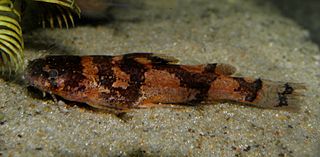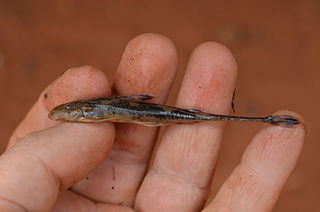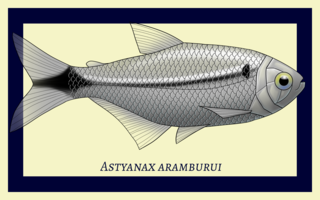
Characidae, the characids or characins is a family of freshwater subtropical and tropical fish, belonging to the order Characiformes. The name "characins" is the historical one, but scientists today tend to prefer "characids" to reflect their status as a by and large monophyletic group at family rank. To arrive there, this family has undergone much systematic and taxonomic change. Among those fishes that remain in the Characidae for the time being are the tetras, comprising the very similar genera Hemigrammus and Hyphessobrycon, as well as a few related forms such as the cave and neon tetras. Fish of this family are important as food and also include popular aquarium fish species.

Hypostomus is a genus of catfish in the family Loricariidae. They are native to tropical and subtropical South America. H. plecostomus is the popular freshwater aquarium fish formerly known as Plecostomus plecostomus. The taxonomic structure of the Loricariidae is still being expanded by scientists. Hypostomus is a highly species-rich and widely distributed catfish genus.

Microglanis is a genus of fish in the family Pseudopimelodidae native to South America. This genus has the widest distribution within its family, with species ranging from the Guianas to Venezuela; western slope of the Andes in Ecuador and Peru to the Río de La Plata basin in Argentina. They occur eastward to the Orinoco and Amazon basins. It is also present in the eastern coastal rivers of Brazil.
Microglanis leptostriatus is a species of catfish belonging to the family Pseudopimelodidae. It appears to be entirely restricted to the middle and upper basin of the São Francisco River in Brazil.

Auchenipterichthys is a genus of driftwood catfishes found in South America.
Isbrueckerichthys is a genus of armored catfishes native to South America.
Pseudotocinclus is a genus of armored catfishes native to South America.
Cetopsidium is a genus of catfishes of the family Cetopsidae.

Paracetopsis is a genus of whale catfishes found in tropical South America.

Cetopsis is a genus of catfishes of the family Cetopsidae.

Doumea is a genus of loach catfishes native to Africa.
Curimatopsis is a genus of small South American fish in the family Curimatidae. They are native to freshwater habitats in the Amazon, Orinoco and Paraguay basins, as well as river of the Guianas.
Archolaemus luciae is a species of glass knifefish endemic to Brazil where it is found in the Rio Jari, the Rio Trombetas and the Rio Tapajós basins in the eastern Amazon. Also found in the Rio Araguari. This species reaches a length of 49.7 cm (19.6 in).

Bryconops cyrtogaster is a midsize species of freshwater fish found in the rivers of South America. It is overall silver, with an indistinct dark patch at the base of the tail fin that spreads onto the fin rays slightly. Originally described in 1926 under a different baisonym, it was the subject of a redescription in June 2020.
Bryconops vibex is a small freshwater fish from the rivers of Venezuela, known solely from the Rio Cataniapo. The body is slender, though with an element of sturdiness, and it has one humeral spot by each pectoral fin. It bears visual similarities to several congeners, but can be differentiated by way of many factors.
Bryconops hexalepis is a small iguanodectid fish from the rivers of Brazil. It is solely found in the drainage of the Rio Tocantins. Rather elongate and quite slender, it is considered one of the smaller species of its genus, with tall scales and large eyes.
Bryconops marabaixo is a small freshwater fish from the lower Amazon basin, native to the Rio Jari. It is small and silvery, with a dark-gray back, and its fins are mostly clear, though the caudal fin has a dark stripe on the lower margin of the dorsal lobe, and a spot of red pigment just above that. Like many other members of Bryconops, it has a humeral spot, which is a mark near each pectoral fin.
Piabucus caudomaculatus is a small freshwater fish inhabiting the rivers of South America. It was the first member of the family Iguanodectidae to be reported from Bolivia, and it remains endemic to the region, found solely in the Mamoré river basin. It displays a preference for slow-moving waterways and has a largely insectivorous diet.

Astyanax aramburui is a small freshwater fish from the rivers of South America, restricted to a relatively small region within the Paraná and Uruguay river basins of Argentina. It was named after the scientist who established a professional presence for ichthyology in the country, Raúl Arámburu. Considered a near-threatened species by the IUCN, its range includes creeks in a sub-basin affected by various forms of pollution.

Astyanax biotae is a small species of freshwater fish native to various localities in Brazil. It primarily eats invertebrates, like copepods and aquatic fly larvae, and its diet also includes seeds, fruits, and filamentous algae. Its scales are largely silver, with a touch of yellow-brown on the back and a hint of blue on the sides. Like many species of Astyanax, it has a humeral spot, which is a blotch of pigmentation in the area above or around the pectoral fin.









